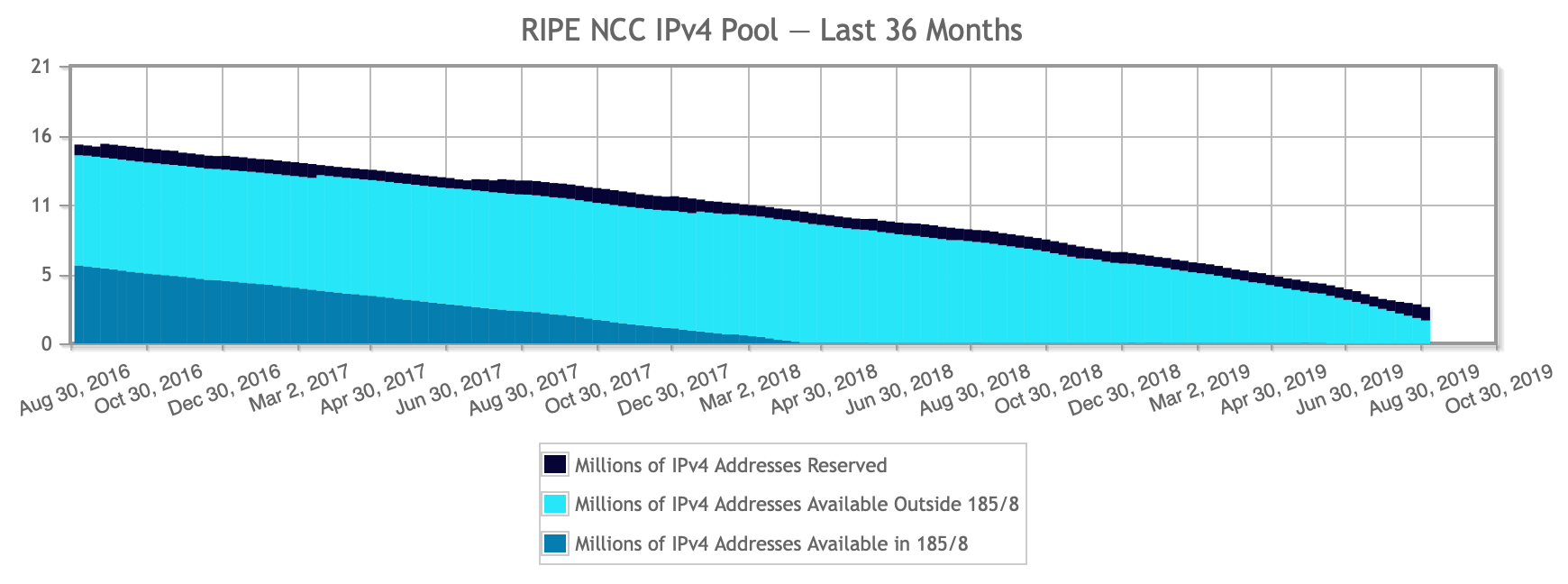Europe runs out of IPv4 addresses even further, what now?
▼ Less than three months ago I wrote about how the uptake of the remaining IPv4 addresses at RIPE was accelerating, with the RIPE NCC likely to run out of the addresses set aside in the "last /8" before the end of the year. And so they did, two days ago. So as of this week, it's no longer possible to request address space in the RIPE service region (Europe, former Soviet Union, Middle East) and get them within a somewhat predictable period.
In September, a million IPv4 addresses were given out every six weeks, and that rate seems to have continued. That's about a thousand /22s (blocks of 1024 IPv4 addresses), where each LIR ("RIPE member") can only get one of those. Thus, most of these blocks must have gone to new LIRs, at a rate of nearly a thousand every 30 business days, so the RIPE NCC must have been processing a new LIR, or at least a /22, every 15 minutes or so!
So what if you're in the RIPE region and you need IPv4 addresses in order to talk to the part of the internet that hasn't adopted IPv6 yet?
The RIPE NCC is not completely out of the game, so one option is to go on the waiting list.
LIRs "that have never received an IPv4 allocation from the RIPE NCC can make a request via the waiting list". So: sign up to be an LIR, put in a request, and wait for address space to become available. At that point you'll get a /24. Note that the NCC does in fact get back IPv4 address space at some rate, and there's currently nearly half a million addresses (about 2000 /24s) in quarantine, which lasts for six months if I'm informed correctly. So presumably, on average 75 /24s should become available every week over the next six months.
So it seems the game where a single organization would just sign up multiple RIPE memberships to qualify for a small block of IPv4 space multiple times can continue. However, you'll only get a quarter of the address space and there will be an unpredictable delay. So I'm thinking that the people who wanted to play that game were trying to take advantage of the /22-per-LIR policy and we're going to see less of this.
ARIN (North America) didn't have a final /8 policy, and has had a waiting list in operation for some years now. Currently, there are 160 requests on the list, and the next in line has been waiting for about six months.
The alternative is to buy IPv4 addresses on the open market. The going rate seems to be around $20 per address right now.
All of this puts a lot of pressure on IPv4 addresses for those organizations that weren't around when it was easy to get IPv4. So those organizations need to deploy address sharing techniques such as "carrier grade NAT" (CGN/CGNAT), "large scale NAT" (LSN) or stateful NAT64.
But what about IPv6? IPv6 addresses are for all intents and purposes free. However, you can't use IPv6 to communicate with a system that only has IPv4. But it makes sense to do as much as possible over IPv6 and only use translators to share IPv4 addresses when necessary. This limits the amount of address space required as well as the equipment that has to do all the NATing.
Permalink - posted 2019-11-27

